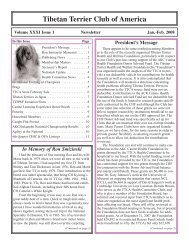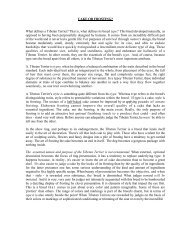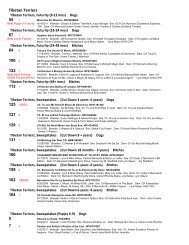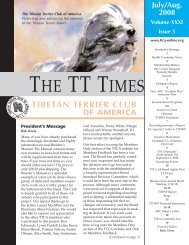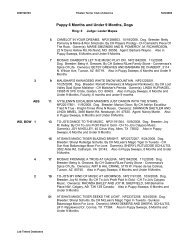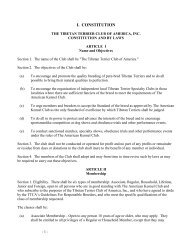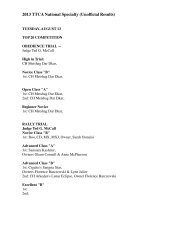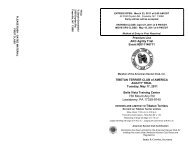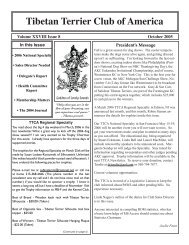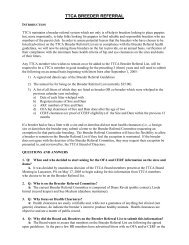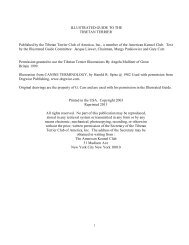Judging the Tibetan Terrier - Tibetan Terrier Club of America
Judging the Tibetan Terrier - Tibetan Terrier Club of America
Judging the Tibetan Terrier - Tibetan Terrier Club of America
You also want an ePaper? Increase the reach of your titles
YUMPU automatically turns print PDFs into web optimized ePapers that Google loves.
The <strong>Tibetan</strong> <strong>Terrier</strong> <strong>Club</strong> <strong>of</strong> <strong>America</strong> would like to call your attention to several essentialbreed specific areas that are being affected by judging decisions which are contrary to ourbreed standard. It is imperative when judging <strong>the</strong> <strong>Tibetan</strong> <strong>Terrier</strong> that <strong>the</strong> background <strong>of</strong>Tibet’s extreme climate and difficult terrain be considered in <strong>the</strong> evolution <strong>of</strong> this breed.These extremely harsh conditions require <strong>the</strong> <strong>Tibetan</strong> <strong>Terrier</strong> to have abundant, protectivecoat. Our standard reflects this in describing <strong>the</strong> <strong>Tibetan</strong> <strong>Terrier</strong> as a dog that ispr<strong>of</strong>usely coated. The proper double coat is an essential breed characteristic andconsists <strong>of</strong> a s<strong>of</strong>t, woolly undercoat and an abundant, fine textured outer coat. While <strong>the</strong>outer coat hair shaft is a fine texture (as opposed to <strong>the</strong> Lhasa Apso which has a heavy,straight, hard coat) <strong>the</strong> <strong>Tibetan</strong> <strong>Terrier</strong>’s outer coat should not be ei<strong>the</strong>r silky or wooly.The depth <strong>of</strong> <strong>the</strong> undercoat layer may vary by breeding lines, climate, or estrus but shouldalways be apparent in an adult <strong>Tibetan</strong> <strong>Terrier</strong>. Due to <strong>the</strong> varied nature <strong>of</strong> <strong>the</strong> changingcoat pattern, young adults should not be penalized for having a “half and half” texture.Adult coat generally comes in first over <strong>the</strong> shoulders but can take a year or even longerfor <strong>the</strong> entire coat to change to adult texture. (Puppy coats are single, shorter and may bes<strong>of</strong>ter than adult coats). Please pay special attention to <strong>the</strong> fact that <strong>the</strong> outer coat andundercoat are <strong>of</strong> different textures – this is essential for insulation and protection in <strong>the</strong><strong>Tibetan</strong> climate.While this is a “coated breed” it is not a “coat breed”. The coat may be ei<strong>the</strong>r wavy orstraight. There should be no preference given to ei<strong>the</strong>r a wavy coat or a naturally straightcoat. Ironing <strong>of</strong> <strong>the</strong> coat is contrary to <strong>the</strong> natural presentation required by <strong>the</strong> standardand should not be rewarded or encouraged. In addition, <strong>the</strong>re are no preferred colors orcombination <strong>of</strong> colors in <strong>the</strong> <strong>Tibetan</strong> <strong>Terrier</strong>. Different coat colors reflect light differentlyand <strong>the</strong> breed has variations <strong>of</strong> both shiny colors and matte colors; please do not confuselight reflection with conditioning. The lack <strong>of</strong> a fall <strong>of</strong> hair over <strong>the</strong> eyes and foreface isalso a fault. This fall was again a protective measure to guard <strong>the</strong> eyes from <strong>the</strong> harshsunlight as well as strong winds and dirt.According to our standard, “The <strong>Tibetan</strong> <strong>Terrier</strong> is shown as naturally as possible.” Itgoes on to state “Sculpturing, scissoring, stripping or shaving are totally contrary tobreed type and are serious faults”. Requiring <strong>the</strong> dog to be shown as naturally aspossible does not mean unkempt – <strong>the</strong> exhibit should be clean, brushed and free <strong>of</strong> mats.The only trimming allowable under <strong>the</strong> standard is to <strong>the</strong> hair between <strong>the</strong> toes and pads,which may be trimmed level with <strong>the</strong> underside <strong>of</strong> <strong>the</strong> pads for health reasons. OurIllustrated Guide to <strong>the</strong> <strong>Tibetan</strong> <strong>Terrier</strong> clearly states our position that both <strong>the</strong> exhibitorswho show scissored and sculpted dogs and <strong>the</strong> judges who reward <strong>the</strong>m show anintentional and blatant disregard for <strong>the</strong> standard. While <strong>the</strong>se seem like harsh words,<strong>the</strong>y demonstrate how determined we are as <strong>the</strong> Parent <strong>Club</strong> to maintaining <strong>the</strong> naturaland charming look <strong>of</strong> our breed.Many years ago an excellent article regarding overgrooming was sent to all judges <strong>of</strong><strong>Tibetan</strong> <strong>Terrier</strong>s entitled Cake or Frosting?. I would encourage you to review thisarticle before your next TT assignment. If you have fur<strong>the</strong>r questions or would like torequest a copy <strong>of</strong> this article or <strong>the</strong> Illustrated Guide to <strong>the</strong> <strong>Tibetan</strong> <strong>Terrier</strong>, please
contact our Judges Education Chair at: Margy Pankiewicz, Judges Education, TTCA;1645 Seaks Run Rd., Glen Rock, PA 17327;Malishar@msn.com; (717) 235-6991.



